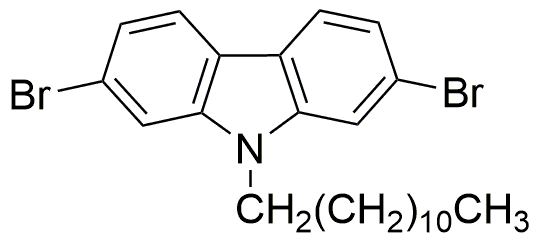2,7-Dibromo-9-dodecylcarbazole is widely utilized in research focused on:
- Organic Electronics: This compound is used in the development of organic light-emitting diodes (OLEDs) and organic photovoltaics (OPVs), enhancing light emission and energy conversion efficiency.
- Polymer Chemistry: It serves as a building block for creating novel polymers with specific electronic properties, which can be applied in flexible electronics and advanced materials.
- Fluorescent Probes: The compound is effective in designing fluorescent probes for biological imaging, allowing researchers to visualize cellular processes with high specificity.
- Photovoltaic Devices: Its unique structure contributes to improved charge transport in solar cells, making it a valuable component in the quest for more efficient renewable energy solutions.
- Research in Photonics: This chemical is explored for its potential in photonic applications, particularly in the development of light-harvesting systems and sensors.
General Information
Properties
Safety and Regulations
Applications
2,7-Dibromo-9-dodecylcarbazole is widely utilized in research focused on:
- Organic Electronics: This compound is used in the development of organic light-emitting diodes (OLEDs) and organic photovoltaics (OPVs), enhancing light emission and energy conversion efficiency.
- Polymer Chemistry: It serves as a building block for creating novel polymers with specific electronic properties, which can be applied in flexible electronics and advanced materials.
- Fluorescent Probes: The compound is effective in designing fluorescent probes for biological imaging, allowing researchers to visualize cellular processes with high specificity.
- Photovoltaic Devices: Its unique structure contributes to improved charge transport in solar cells, making it a valuable component in the quest for more efficient renewable energy solutions.
- Research in Photonics: This chemical is explored for its potential in photonic applications, particularly in the development of light-harvesting systems and sensors.
Documents
Safety Data Sheets (SDS)
The SDS provides comprehensive safety information on handling, storage, and disposal of the product.
Product Specification (PS)
The PS provides a comprehensive breakdown of the product’s properties, including chemical composition, physical state, purity, and storage requirements. It also details acceptable quality ranges and the product's intended applications.
Certificates of Analysis (COA)
Search for Certificates of Analysis (COA) by entering the products Lot Number. Lot and Batch Numbers can be found on a product’s label following the words ‘Lot’ or ‘Batch’.
*Catalog Number
*Lot Number
Certificates Of Origin (COO)
This COO confirms the country where the product was manufactured, and also details the materials and components used in it and whether it is derived from natural, synthetic, or other specific sources. This certificate may be required for customs, trade, and regulatory compliance.
*Catalog Number
*Lot Number
Safety Data Sheets (SDS)
The SDS provides comprehensive safety information on handling, storage, and disposal of the product.
DownloadProduct Specification (PS)
The PS provides a comprehensive breakdown of the product’s properties, including chemical composition, physical state, purity, and storage requirements. It also details acceptable quality ranges and the product's intended applications.
DownloadCertificates of Analysis (COA)
Search for Certificates of Analysis (COA) by entering the products Lot Number. Lot and Batch Numbers can be found on a product’s label following the words ‘Lot’ or ‘Batch’.
*Catalog Number
*Lot Number
Certificates Of Origin (COO)
This COO confirms the country where the product was manufactured, and also details the materials and components used in it and whether it is derived from natural, synthetic, or other specific sources. This certificate may be required for customs, trade, and regulatory compliance.


